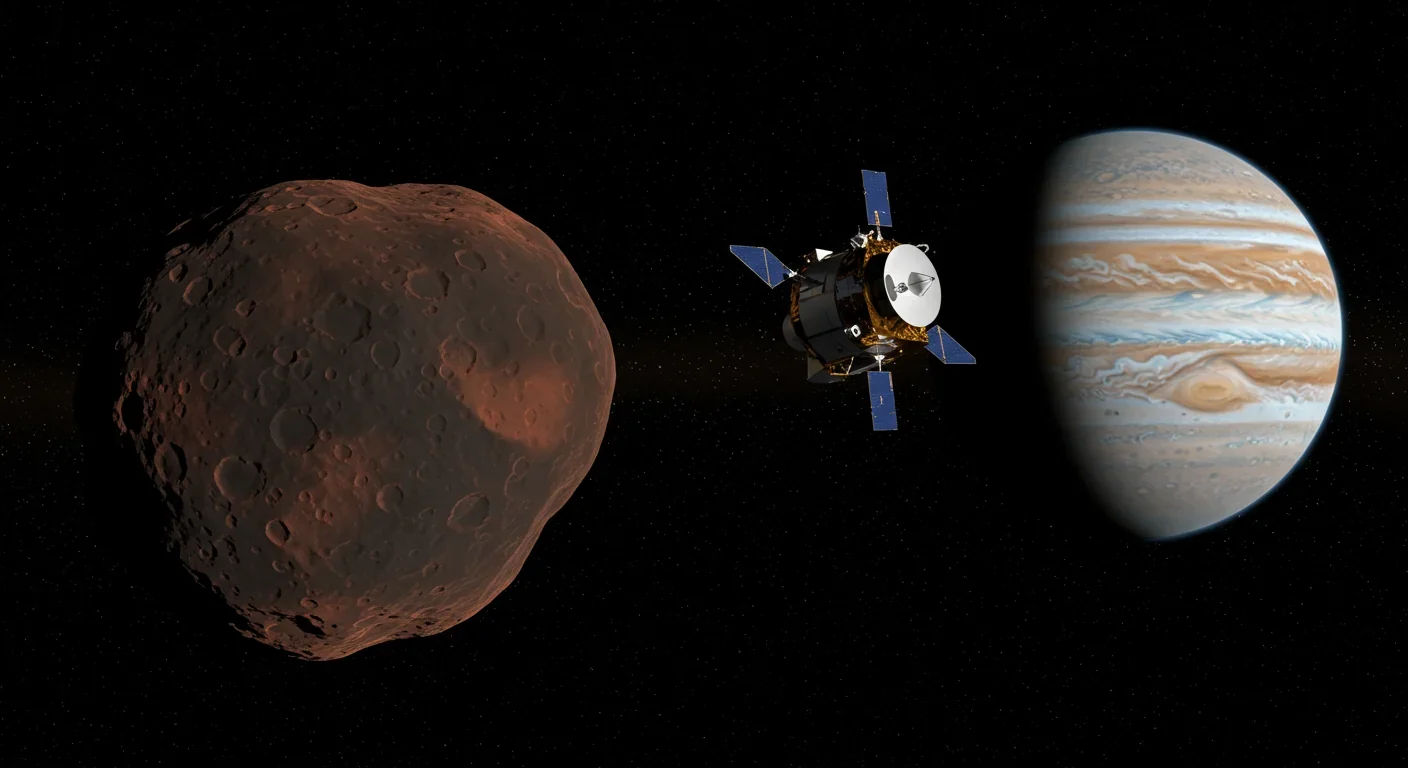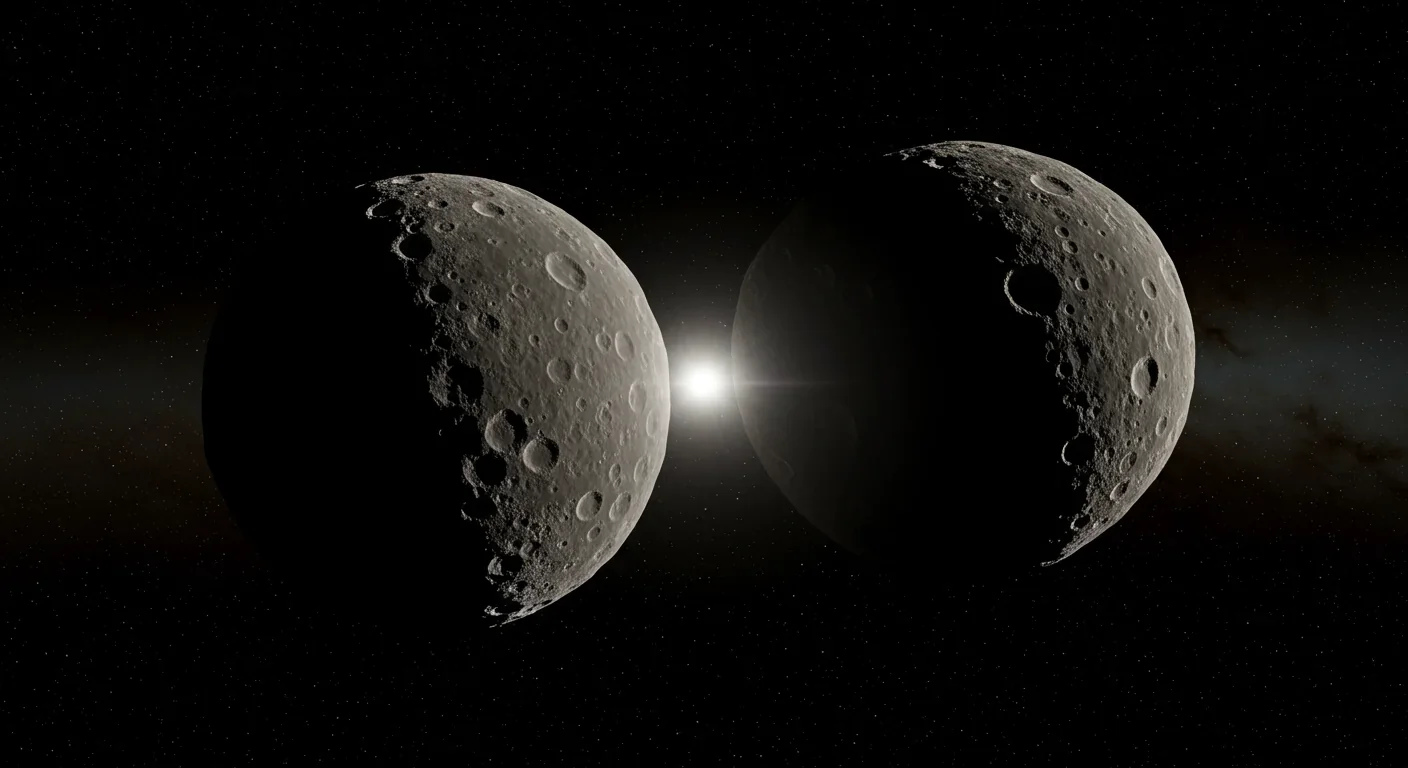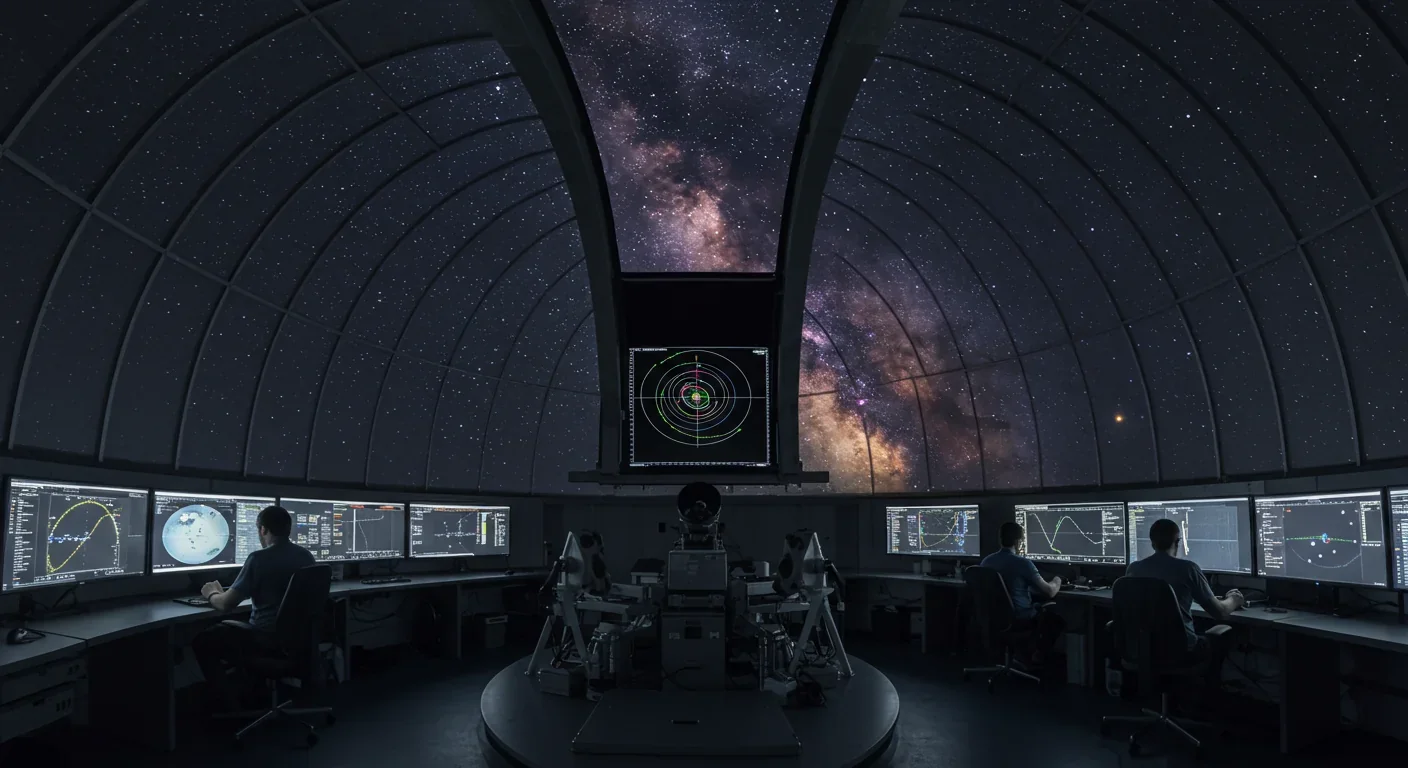The Gravity Heresy: MOND vs Dark Matter Theory Explained

TL;DR: Jupiter's Trojan asteroids are ancient space rocks trapped in gravitational sweet spots for over 4 billion years, preserving pristine materials from the solar system's formation. NASA's Lucy mission will visit eight of these objects by 2033, revealing how planetary migration shaped our cosmic neighborhood and possibly delivered the building blocks of life to Earth.

By 2033, when NASA's Lucy spacecraft completes its grand tour of Jupiter's Trojan asteroids, scientists expect to rewrite significant chapters of planetary formation theory. These ancient space rocks, trapped in gravitational sweet spots for over 4 billion years, have preserved secrets from our solar system's chaotic infancy that no other celestial bodies can match. What started as a curious mathematical prediction in the 18th century has evolved into one of astronomy's most compelling detective stories, with implications that reach far beyond Jupiter's orbit.
Jupiter's Trojans aren't just ordinary asteroids wandering through space. They're cosmic prisoners, held in two massive swarms that share Jupiter's orbit around the Sun, locked in position by an elegant gravitational dance discovered by mathematician Joseph-Louis Lagrange in 1772. These Lagrange points, specifically L4 and L5, sit 60 degrees ahead of and behind Jupiter in its orbit, creating gravitational "parking spots" where the Sun's and Jupiter's gravity balance perfectly.
The first Trojan asteroid, 588 Achilles, was discovered in 1906 by German astronomer Max Wolf. Since then, astronomers have cataloged nearly 10,000 members of these two camps, with population estimates suggesting over one million objects larger than one kilometer exist in total. That makes them roughly as numerous as the main asteroid belt between Mars and Jupiter.
What makes these asteroids captivating isn't their number, but their nature. Unlike asteroids in the main belt that have been battered and chemically altered over billions of years, Trojans appear remarkably pristine. They've remained in stable orbits, protected from most collisions, preserving materials from the solar system's formation like geological time capsules.
The naming convention for these asteroids reflects astronomy's playful side. After Max Wolf discovered 588 Achilles at the L4 point ahead of Jupiter, astronomers adopted a convention honoring Homer's Iliad. Asteroids in the leading swarm were named after Greek warriors (the "Greek camp"), while those trailing Jupiter became "Trojans," named after defenders of Troy.
The system isn't perfect. In the rush of early discoveries, one Trojan ended up in the Greek camp (617 Patroclus) and one Greek in the Trojan camp (624 Hektor), creating what astronomers now call "spies" in the opposing camps. 617 Patroclus turned out to be particularly interesting: it's actually a binary system, two objects orbiting each other, making it a prime target for NASA's Lucy mission.
Discovery accelerated dramatically in the 1990s and 2000s with automated sky surveys. What took 70 years to find 1,000 Trojans now takes months. The Catalina Sky Survey and other programs routinely discover dozens of new Trojans yearly, refining our understanding of their distribution and characteristics.
Spectroscopic studies reveal that Trojans are fundamentally different from main-belt asteroids. Most appear to be dark, primitive objects with surfaces that reflect only 3-7% of incident sunlight, making them darker than coal. This low albedo suggests their surfaces are rich in organic compounds and carbon-based materials that have barely changed since the solar system's formation.
Recent observations show two main compositional groups. The majority are "D-type" and "P-type" asteroids, characterized by reddish, featureless spectra indicating they're covered in organic-rich material. Some show spectral features suggesting the presence of water ice beneath their surfaces, though solar heating at Jupiter's distance should have removed most surface volatiles long ago.
Thermal observations from infrared surveys reveal Trojans are surprisingly low in density, typically around 1.0-2.0 grams per cubic centimeter. That's barely denser than water, suggesting they're not solid rock but rather loosely bound "rubble piles" with significant internal voids. This porous structure tells us something profound: many Trojans likely formed gently through accumulation of dust and ice in the outer solar system, rather than being fragments from violent collisions.
The presence of volatile compounds is the real clue. These materials evaporate easily when heated, which means Trojans couldn't have formed near their current location. Jupiter's orbit receives too much solar radiation to preserve such delicate chemistry. Instead, Trojans must have formed much farther from the Sun, in the cold outer reaches beyond Neptune, before being captured during a period of planetary chaos.

Understanding how Trojans stay put requires grasping one of physics' most elegant concepts: the three-body problem. When you have two massive bodies like the Sun and Jupiter, their gravitational fields create five special points where a small object can maintain a stable position relative to both. The L4 and L5 points, positioned 60 degrees ahead and behind Jupiter, are the most stable of these Lagrange points.
But "stable" doesn't mean stationary. Trojans don't sit motionless at these points. Instead, they perform a complex dance called libration, oscillating around the Lagrange points in tadpole-shaped or horseshoe-shaped orbits that can span millions of kilometers. Some Trojans complete these oscillations in decades; others take centuries.
NASA's visualization models show this motion beautifully. As viewed from Jupiter, Trojans appear to slowly circle the L4 or L5 point while Jupiter orbits the Sun. This motion results from the interplay between the asteroids' momentum and the combined gravitational influence of the Sun and Jupiter, creating a self-correcting system. When an asteroid drifts too far from the Lagrange point, gravitational forces gently pull it back.
The stability isn't perfect or permanent. Computer simulations suggest most Trojans remain stable for hundreds of millions or even billions of years, but some orbits are chaotic on geological timescales. Trojan 2010 TK7, discovered at Earth's L4 point, demonstrates this instability. Its orbit has a much larger libration amplitude than Jupiter's Trojans, and simulations suggest it may not have been Earth's companion for the planet's entire history, and probably won't remain there indefinitely.
Launched in October 2021, NASA's Lucy spacecraft represents humanity's first dedicated mission to study Trojan asteroids up close. Named after the famous human ancestor fossil, Lucy aims to shed light on our solar system's origins just as the fossil Lucy illuminated human evolution.
Lucy's 12-year journey is audacious by any measure. The spacecraft will visit eight asteroids including one main-belt asteroid (52246 Donaldjohanson) and seven Trojans, making it NASA's first mission to visit more targets than any previous solar system exploration mission. The trajectory required innovative planning, including multiple Earth gravity assists to build up the speed needed to reach Jupiter's distance.
The mission's primary targets span both Trojan camps and represent diverse Trojan types. They include 3548 Eurybates and its satellite, 15094 Polymele (which surprised scientists by revealing its own small moon during pre-flyby observations), 11351 Leucus, and 21900 Orus in the Greek camp, plus the binary pair 617 Patroclus-Menoetius in the Trojan camp. Each encounter will capture detailed images, measure composition through spectroscopy, and determine internal structure through precise mass measurements.
In November 2023, Lucy achieved its first asteroid encounter, flying past 152830 Dinkinesh in the main belt. The flyby revealed Dinkinesh to be a binary system, with a small satellite dubbed "Selam" orbiting the main body. Even more surprisingly, Selam itself turned out to be a contact binary, two lobes touching each other. This unexpected complexity from the very first target suggested Lucy's primary mission would deliver surprises.
The scientific payload includes high-resolution cameras, infrared and visible spectrometers to analyze surface composition, and a thermal emission spectrometer to measure surface temperatures and thermal properties. Together, these instruments will answer fundamental questions: What are Trojans made of? How did they form? When were they captured into their current orbits?
Trojans aren't just interesting objects; they're witnesses to the solar system's most dramatic period. Current planetary formation theory, particularly the Nice model developed in the mid-2000s, suggests the outer planets didn't form where we find them today. Instead, they were born in a more compact configuration and subsequently migrated to their current positions through gravitational interactions.
About 4 billion years ago, this migration triggered chaos. As Jupiter and Saturn crossed orbital resonances, their gravitational relationship suddenly changed, disrupting the orbits of Uranus and Neptune. These ice giants, in turn, plowed through the primordial Kuiper Belt, a massive disk of icy bodies beyond Neptune's original orbit. The result was a cosmic billiard game called the Late Heavy Bombardment, when the inner solar system was pelted with asteroids and comets.
Trojans preserve evidence of this upheaval. Computer models suggest they were captured during this migration period, when Jupiter's Lagrange points swept through the population of small bodies being scattered by Neptune's migration. The Nice model predicts that captured Trojans should have compositions matching objects from the outer solar system, which is exactly what observations show.
The implications extend to Earth's history. If Trojans came from the outer solar system, and they contain water ice and organic compounds, they represent the kind of material that may have been delivered to the inner planets during the Late Heavy Bombardment. Some scientists speculate that comets and carbonaceous asteroids from this region may have delivered much of Earth's water and the organic building blocks necessary for life.
Studying Trojans also constrains the timeline of planetary migration. If Trojans were captured 4 billion years ago, their surfaces should show evidence of that age through crater counts and space weathering effects. If some Trojans are younger captures, that would indicate the outer solar system remained dynamically active longer than current models suggest.

Lucy is just the beginning. The mission's success has energized proposals for follow-up missions, including concepts for landing on a Trojan or even returning samples to Earth. A sample return mission could definitively answer questions about Trojan composition that remote spectroscopy can't fully resolve, such as the precise isotopic ratios that would confirm their outer solar system origin.
Ground-based astronomy continues advancing too. Large telescopes equipped with adaptive optics can now resolve binary Trojans and measure their orbits precisely enough to calculate densities. The upcoming Vera C. Rubin Observatory, with its ability to survey the entire visible sky every few nights, will likely discover thousands more Trojans and track their orbits with unprecedented precision.
There's growing interest in Trojans as destinations for human exploration, though that remains speculative. Their distance poses obvious challenges, but their low gravity and potentially rich resources (water, organic compounds, minerals) make them intriguing targets for far-future missions. Some studies suggest Trojans might be easier to reach than the main asteroid belt despite being farther away, since spacecraft could use Jupiter's gravity to reach them more efficiently.
Scientists are also searching for Trojans around other planets. Mars has confirmed Trojans, though far fewer than Jupiter. Saturn recently gained its first confirmed Trojan, though its orbit suggests it may be a temporary capture. Even Earth hosts at least one confirmed Trojan, 2010 TK7, discovered using infrared data from NASA's WISE telescope.
The search for exo-Trojans—Trojan asteroids orbiting stars other than the Sun—represents another frontier. While current telescopes can't directly image such small objects around distant stars, astronomers have proposed clever techniques using transit timing variations that might reveal their presence indirectly. Finding exo-Trojans would confirm that these gravitational configurations are common throughout the galaxy.
Step back from the technical details, and Trojans represent something profound about how science works. These asteroids were predicted mathematically decades before the first one was discovered. Their existence confirms theories about gravity and orbital mechanics that have applications far beyond astronomy, from satellite constellations to space station positioning.
They also remind us that our solar system isn't the stable, unchanging clockwork that early astronomers imagined. It's a dynamic system that has undergone dramatic changes, with planets migrating, objects being captured and ejected, and countless collisions reshaping the landscape. We live in the aftermath of this chaos, on a planet whose water and organic chemistry may have been delivered by objects similar to Trojans.
Perhaps most importantly, Trojans demonstrate that some of the most interesting discoveries come from studying things that don't seem obviously important. For decades, Trojans were astronomical curiosities, footnotes in textbooks about orbital mechanics. Only as our understanding of solar system formation deepened did we recognize them as critical evidence.
Jupiter's Trojan asteroids have been trapped in their gravitational prisons for most of the solar system's history, circling ahead of and behind the giant planet in a cosmic parade that will likely continue for billions of years. Yet despite their captivity, these dark, primitive bodies hold tremendous freedom in what they can teach us.
They've preserved chemistry from the solar system's birth that has been destroyed almost everywhere else. They encode in their orbits and compositions a record of planetary migration that happened 4 billion years ago. They may share origins with the objects that delivered water to Earth, making them distant relatives of everything that lives on our planet.
As Lucy begins its encounters with these ancient captives over the next decade, each flyby will add another piece to the puzzle. The images, spectra, and data it returns won't just be about asteroids, they'll be chapters in the story of how our solar system formed, evolved, and ultimately became capable of producing observers curious enough to wonder about rocks trapped in Jupiter's gravitational shadow.
The captives may be ancient, but the secrets they're about to reveal will be very new indeed.

MOND proposes gravity changes at low accelerations, explaining galaxy rotation without dark matter. While it predicts thousands of galaxies correctly, it struggles with clusters and cosmology, keeping the dark matter debate alive.

Ultrafine pollution particles smaller than 100 nanometers can bypass the blood-brain barrier through the olfactory nerve and bloodstream, depositing in brain tissue where they trigger neuroinflammation linked to dementia and neurological disorders, yet remain completely unregulated by current air quality standards.

CAES stores excess renewable energy by compressing air in underground caverns, then releases it through turbines during peak demand. New advanced adiabatic systems achieve 70%+ efficiency, making this decades-old technology suddenly competitive for long-duration grid storage.

Our brains are hardwired to see patterns in randomness, causing the gambler's fallacy—the mistaken belief that past random events influence future probabilities. This cognitive bias costs people millions in casinos, investments, and daily decisions.

Forests operate as synchronized living systems with molecular clocks that coordinate metabolism from individual cells to entire ecosystems, creating rhythmic patterns that affect global carbon cycles and climate feedback loops.

Generation Z is the first cohort to come of age amid a polycrisis - interconnected global failures spanning climate, economy, democracy, and health. This cascading reality is fundamentally reshaping how young people think, plan their lives, and organize for change.

Zero-trust security eliminates implicit network trust by requiring continuous verification of every access request. Organizations are rapidly adopting this architecture to address cloud computing, remote work, and sophisticated threats that rendered perimeter defenses obsolete.